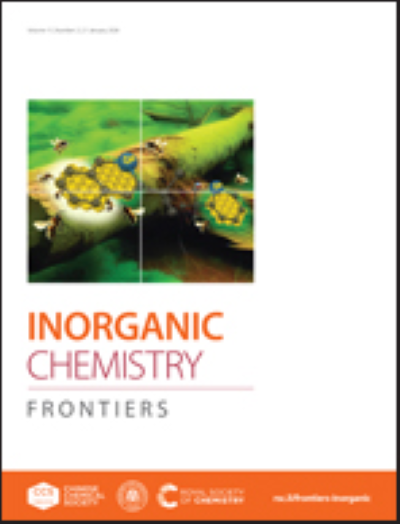三角反棱镜单核Cr(II)自旋交叉配合物
IF 6.1
1区 化学
Q1 CHEMISTRY, INORGANIC & NUCLEAR
引用次数: 0
摘要
Cr(II)配合物的自旋交叉(SCO)现象的工程仍然知之甚少,主要是由于报道的例子数量有限以及合成中的相关挑战。在具有八面体几何结构的Cr(II)配合物中,高自旋(HS)态明显的Jahn-Teller畸变极大地限制了SCO发生所需的共配体的选择。在本研究中,我们成功合成了一系列空气稳定的无溶剂Cr(II)配合物,[Cr(TpmR)2]X2 (TpmR = Tpm: X = [BF4]-, 1;X = [ClO4]-, 2;TpmR = Tpm*: X = [BF4]-, 3;X = [ClO4]-, 4),其中Cr(II)离子采用三角形反棱镜(aTPR)几何形状,而不是传统的八面体结构。值得注意的是,基于tpm的配合物1和2具有接近理想的aTPR几何形状的Cr(II)离子,在转变温度(T1/2)分别为190 K(1)和194 K(2)时表现出完全的SCO行为。相比之下,基于Tpm*的配合物3和4在aTPR结构中表现出相当大的轴向伸长,导致3在更低的温度下(T1/2 = 142 K)发生突然但不完全的SCO转变,而4主要保持HS状态。进一步的结构分析表明,用[ClO4]- in - 4取代[BF4]-会导致延伸率增加和更密集的填充排列,不利于自旋转变。我们的研究结果表明,aTPR结构有利于促进自旋交叉,而这些配合物中的自旋转变动力学与[Cr(TpmR)2]2+阳离子的结构畸变密切相关。此外,所有配合物都表现出显著的抗氧性,并保持空气稳定性,这可归因于它们紧凑的空间填充结构,有效地阻止了氧气扩散到晶格的间隙区域。本文章由计算机程序翻译,如有差异,请以英文原文为准。
Trigonal Antiprismatic Mononuclear Cr(II) Spin-Crossover Complexes
The engineering of Cr(II) complexes for spin crossover (SCO) phenomena remains poorly understood, primarily due to the limited number of reported examples and the associated challenges in their synthesis. In the context of Cr(II) complexes with octahedral geometry, the pronounced Jahn-Teller distortion in the high-spin (HS) state significantly restricts the selection of co-ligands necessary for SCO to occur. In this study, we successfully synthesized a series of air-stable and solvent-free Cr(II) complexes, [Cr(TpmR)2]X2 (TpmR = Tpm: X = [BF4]-, 1; X = [ClO4]-, 2; TpmR = Tpm*: X = [BF4]-, 3; X = [ClO4]-, 4), where the Cr(II) ions adopt a trigonal antiprism (aTPR) geometry rather than the conventional octahedral configuration. Notably, the Tpm-based complexes 1 and 2, with Cr(II) ions in a nearly ideal aTPR geometry, exhibit complete SCO behavior with transition temperatures (T1/2) of 190 K for 1 and 194 K for 2, respectively. In contrast, the Tpm*-based complexes 3 and 4 display considerable axial elongation within the aTPR structure, leading to abrupt but incomplete SCO transition at a much lower temperature for 3 (T1/2 = 142 K) while 4 remains predominantly in the HS state. Further structural analysis reveals that substituting [BF4]- with [ClO4]- in 4 results in increased elongation and a denser packing arrangement that disfavour the spin transition. Our findings suggest that the aTPR configuration is advantageous for facilitating spin crossover, while the dynamics of spin transitions in these complexes are closely linked to the structural distortions of the [Cr(TpmR)2]2+ cations. Furthermore, all complexes demonstrate remarkable resistance to oxygen and maintain air stability, which can be attributed to their compact space-filling structures that effectively impede the diffusion of oxygen into the interstitial regions of the crystal lattice.
求助全文
通过发布文献求助,成功后即可免费获取论文全文。
去求助
来源期刊

Inorganic Chemistry Frontiers
CHEMISTRY, INORGANIC & NUCLEAR-
CiteScore
10.40
自引率
7.10%
发文量
587
审稿时长
1.2 months
期刊介绍:
The international, high quality journal for interdisciplinary research between inorganic chemistry and related subjects
 求助内容:
求助内容: 应助结果提醒方式:
应助结果提醒方式:


